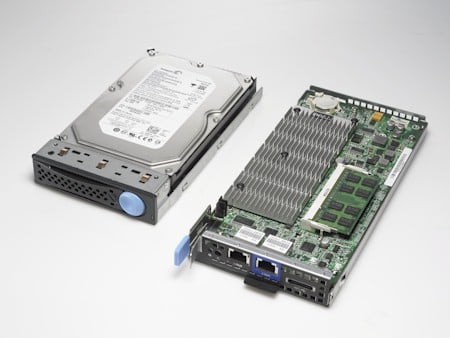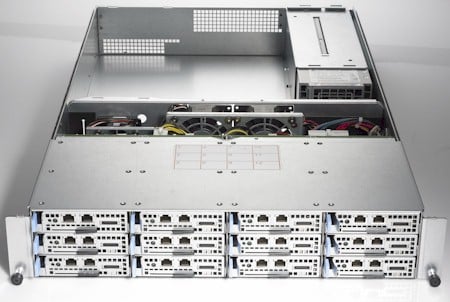This article is more than 1 year old
Dell taps VIA Nano chips for custom mini-servers
Keeping hosters happy
In the Web hosting world, you can charge a premium for customers who have dedicated servers. But Moore's Law and every-more powerful processors combined with server virtualization puts pressure on Web hosting companies to do shared servers for their clients because no modest Web customer can use a whole one-socket or two-socket server today. What's a Web hosting company trying to make profit to do?
Buy servers using physically smaller and less powerful servers, of course.
And that is just what Dell's Data Center Solutions unit, which creates and sells custom-designed server platforms for hyperscale clients, wants to sell to hosting companies. According to Drew Schulke, product marketing manager for the DCS unit, five hosting providers approached Dell because they wanted the option of providing customers with smaller physical servers, perfectly capable of handling Web hosting workloads and not depending on virtualization. Schulke says that the number of machines that these companies have already deployed and their plans to offer dedicated hosting were sufficient to justify investing in custom server designs.
Dell looked around at Intel's Atom processor as well as a few others, but VIA Technologies' Nano processor is the only one of the low-power x64 chips that has the option of supporting virtualization through its VMX virtualization extensions. It isn't so much that these hosting companies want to be able to use virtualization to carve up these servers as it is they want to use virtualization to be able to manage the server image on a dedicated machine. You can't use Xen or KVM - as two early customers for the VIA boxes plan to - to package up a server image on an Atom processor because it does not support Intel's VT instructions.
Dell took the Nano chip and chipset and worked with VIA and an unnamed original design manufacturer to create what it calls a "hot plug server" based on a modified version of VIA's Nano processor and its similarly named motherboard. Using a 1.6 GHz Nano processor and the Dell XS11-VX8 server module, which is slightly longer than a 3.5-inch disk storage bay, Dell can give hosting companies a 64-bit Nano server that has from 1 GB to 3 GB of main memory and that has an idle power draw of around 15 watts and that draws somewhere between 20 and 29 watts under peak loads. That is about one-tenth the power used by a standard two-socket 1U box that is not running at a particularly high utilization.
These hot plug servers are not blade servers, which plug into a midplane for systems management and which share switching and peripherals. But the VIA server modules do slide into a 12-bay server chassis (nicknamed "Fortuna") that gives the devices shared power and cooling. The chassis has a 2U form factor, and it does not have a service processor like commercial-grade PowerEdge rack and blade server chasses do. Schulke says that the hosting shops that were intrigued by the idea of using Nano mobos as servers just wanted a baseboard management controller on the board that supported the IMPI 2.0 protocol, which the VIA board does.
Each VIA server module has 1 GB of DDR2 main memory soldered to it and has a memory slot for supporting an additional 1 GB or 2 GB of memory. The Nano chip on the board runs at 1.6 GHz, but using BIOS settings, it can be geared down to 1.3 GHz, allowing hosting companies to charge a premium for slightly more processing oomph and to save power where customers don't need it. The server package has room for a 2.5-inch disk, which can be a disk drive or a solid state drive, and it also has an SD card slot that can be used as a boot image for an operating system. The server has two Gigabit Ethernet ports as well, and that means one port can be used for networking out to the world and the other can be used to support iSCSI disk arrays.
Dell expects to sell a loaded chassis with a dozen of the VIA server modules for under $4,800, which works out to less than $400 per server node. That means anything over $33 per month per physical server that a hosting company can charge for dedicated hosting can go towards paying for other things, such as salaries or, heaven forbid, profits.
The XS11-VX8 will start shipping at the end of June, and of the 50 DCS customers that Dell has, 14 have asked to look at prototypes of these machines to kick them around and Dell expects that somewhere between 30 and 40 of its custom server buyers will eventually take deliveries of the machines. Hosting providers in China, according to Schulke, will be particularly interested in such machines because they can only get enough reliable electrical power in their data centers to do maybe 3,000 to 4,000 watts per server rack.
That is not very many modern-day quad-core Intel "Nehalem EP" Xeon or Advanced Micro Devices "Shanghai" Opteron servers, and such machines do not fit the desires of small businesses in China to use dedicated servers for their companies at their hosting providers. Using the VIA servers lets hosting providers in China match their electrical power and customer needs.
The Fortuna XS11-VX8 is not going to be a formal PowerEdge product. So once again, Dell has taunted you with a product that you can't buy. But if enough of you are interested, Dell or someone else will get around to commercializing such iron. I can, for instance, imagine six of these Fortuna modules being slapped into a tiny tower case and being sold as a small business box - and one that is perhaps more suited to workloads than the Hewlett-Packard "Shorty" BladeSystem c3000 or IBM BladeCenter S blade boxes. You could put a real Intel Xeon or AMD Opteron processor inside a standard tower box and then let these server modules plug into the storage bays. SMBs are not comfortable with virtualization, and such a machine would admit this and deal with it.
Ever so slowly, the idea of modest computing - using Moore's Law to make smaller and more energy efficient computers, not boosting component counts - seems to be starting to cache on. Just last week, motherboard and whitebox server maker Super Micro announced a server based on the Atom chip. And back in January, Rackable Systems adopted Mini-ITX boards from VIA for use in its MicroSlice rack servers, and Microsoft has been tooling around with the concept too. ®


